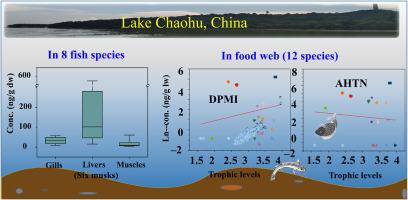Ecotoxicology and Environmental Safety ( IF 6.2 ) Pub Date : 2021-02-22 , DOI: 10.1016/j.ecoenv.2021.112074 Yang Lyu 1 , Shan Ren 2 , Fuyong Zhong 2 , Xue Han 2 , Ying He 1 , Zhenwu Tang 3

|
Synthetic musks (SMs) have drawn worldwide attention, as they are persistent, bioaccumulative, and toxic to many organisms. There is not enough information on the bioaccumulation and trophodynamic behavior of SMs in freshwater food webs to reliably understand the associated ecological risks. In this study, the concentrations of six SM congeners in fifteen aquatic species from Lake Chaohu, China, was investigated. The total concentrations of the six SMs ranged from 0.29 to 59.7 ng/g dry weight (median, 4.41) in fish muscle tissue and in the whole body tissues of small fish species and shrimps. Galaxolide (HHCB) and tonalide (AHTN) were the predominant congeners, accounting for 65.0% and 28.5% of the total SM concentration, respectively. On the whole, the total concentrations of SMs in livers and gills were 0.18–32.8 and 0.84–254 times higher than those in muscle tissues in fish species, respectively. In the food web of Lake Chaohu, cashmeran (DPMI) and HHCB showed a trend towards trophic magnification, and AHTN tended to show trophic dilution, but these trends were not statistically significant. This suggested that the trophic transfer of these chemicals through the food web was strongly influenced by many factors, including tissue-specific distribution within individuals at higher trophic levels. More investigation into the trophic transfer of SMs in aquatic ecosystems and the factors influencing uptake is needed.











































 京公网安备 11010802027423号
京公网安备 11010802027423号